Product Research 101: From Idea to Validation (Amazon & Walmart)
Product Research Powers Validation
Introduction
Every seller dreams of finding that golden product. The truth? It doesn’t happen by chance. Strong sellers on Amazon and Walmart use product research to test ideas before going all in.
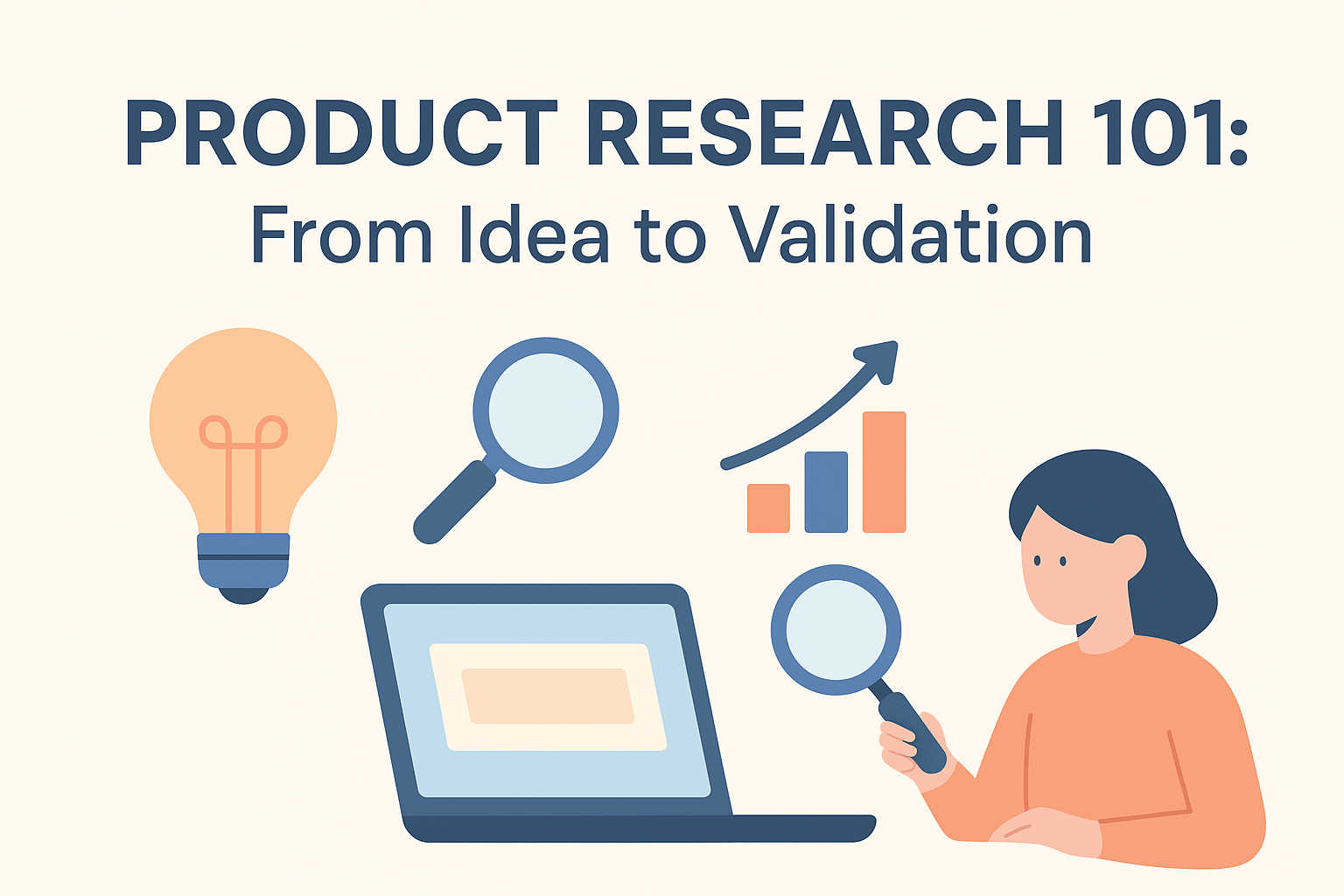
Think of it like a road trip. You don’t just hop in the car and drive blind—you check the map, plan your stops, and make sure you’ve got gas. The same goes for e-commerce. You move from idea to validation step by step.
This guide, Product Research 101: From Idea to Validation, breaks it all down. You’ll see how to brainstorm, test, and lock in winning products. Plus, we’ll dive into both Amazon FBA and Walmart Marketplace so you can hit the ground running.
Key Takeaways
| Step | Focus | Why It Matters |
|---|---|---|
| 1 | Product Research Basics | Build a foundation for smart choices |
| 2 | Understanding the Process | Learn how ideas move toward validation |
| 3 | Step-by-Step Framework | Use a clear roadmap for product picks |
| 4 | Idea Generation & Validation | Test ideas before you risk big money |
| 5 | Amazon-Specific Research | Tailor a strategy for Amazon FBA |
| 6 | Walmart-Specific Research | Tap into Walmart Marketplace growth |
| 7 | Advanced Strategies | Dodge failure and scale with confidence |
Understanding the Product Research Process
When it comes to e-commerce, Amazon and Walmart sellers don’t gamble. They run through a product research process. This process starts with raw ideas and ends with clear validation.
Table: Stages of Product Research
| Stage | Action | Example |
|---|---|---|
| Idea | Brainstorm product categories | Kitchen gadgets, fitness gear |
| Research | Gather data on demand and competition | Amazon Best Sellers, Walmart Trends |
| Validation | Test market fit and profitability | Use Jungle Scout, Helium 10, or Walmart Seller Center |
Bullet Points: Why the Process Matters
-
Keeps you from wasting money on dud products.
-
Shows how customers behave on Amazon and Walmart.
-
Gives proof before bulk orders from Alibaba or local suppliers.
-
Builds confidence in your next launch.
Product research explained: idea to validation
At its core, product research is a journey. You start with a spark of an idea—maybe something you see trending on TikTok, or a gap you notice in Amazon’s catalog. That idea gets tested against demand, competition, and pricing. Once you see positive signs, you move to validation, where tools and test listings confirm it’s a winner.
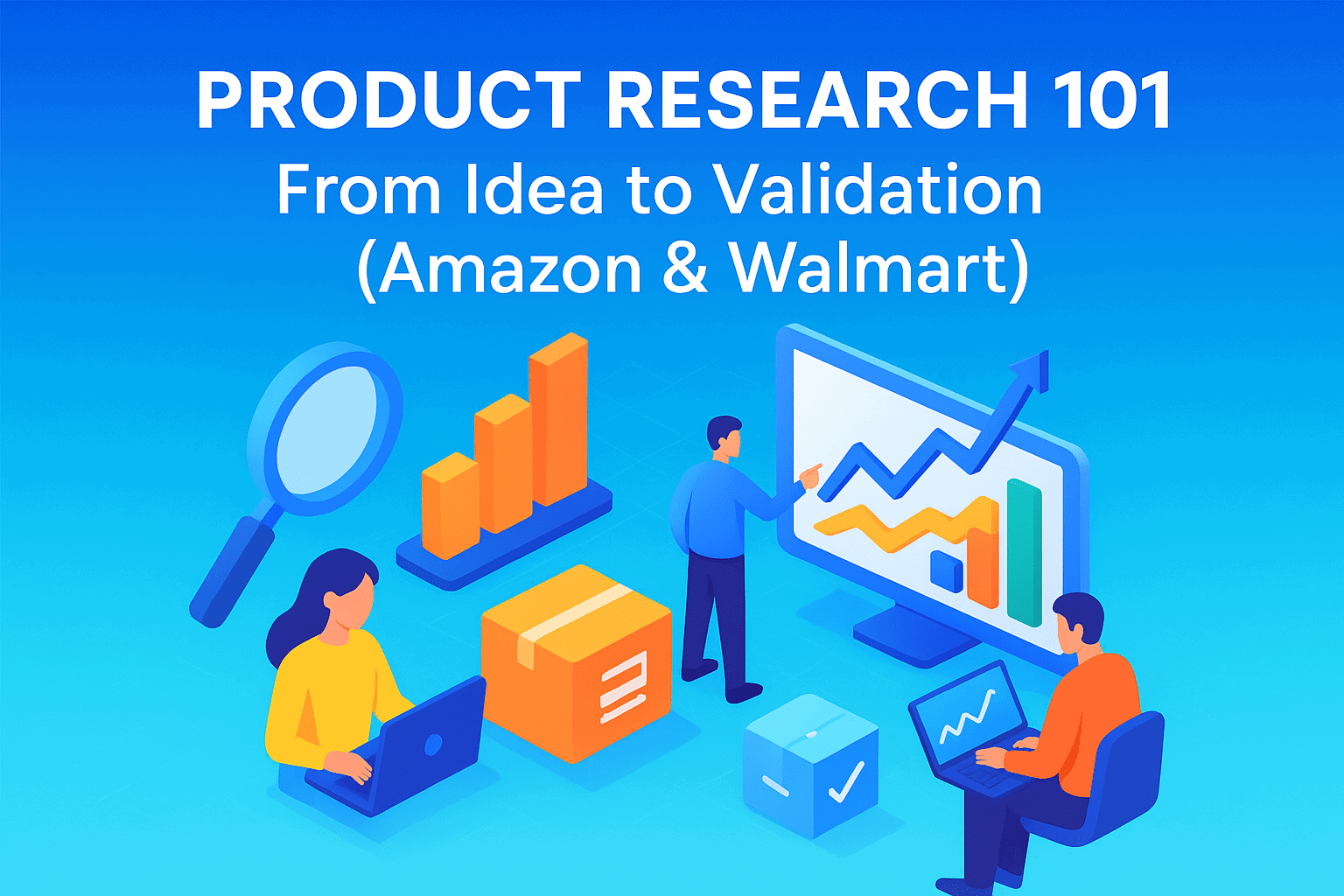
Product research process: idea generation to validation
Think of the process as a funnel. Wide at the top with many ideas and narrow at the bottom with a few proven picks. For instance, a seller on Walmart Marketplace might brainstorm ten categories, run them through Walmart’s search bar, and cut the list to two validated products. It’s a rinse-and-repeat system.
What is the process of product research and validation?
The process mixes data and gut feel. Data comes from tools like Helium 10 for Amazon FBA or DataSpark for Walmart sellers. Gut feel comes from knowing trends, like seeing Stanley cups go viral. When you merge both, you get validation—proof that your product has legs.
Step-by-Step Product Research Framework
A clear framework helps sellers on Amazon and Walmart cut through the noise. Instead of chasing random fads, you’ll follow a roadmap that takes you from raw ideas to validated winners.
Table: Product Research Framework
| Step | Task | Tool / Source | Example |
|---|---|---|---|
| 1 | Brainstorm product niches | Google Trends, Reddit, TikTok | Rising home office tools |
| 2 | Analyze demand | Amazon Best Sellers, Walmart Trends | Standing desk sales |
| 3 | Check competition | Helium 10, DataSpark | Competitor listing analysis |
| 4 | Validate pricing | Keepa, CamelCamelCamel | Track price drops |
| 5 | Test before bulk | FB Ads, small batch orders | Trial run with 100 units |
Bullet Points: Why Frameworks Work
-
Cuts down risk by moving step-by-step.
-
Helps sellers on Amazon FBA and Walmart Marketplace stay organized.
-
Makes it easier to spot trends early.
-
Keeps emotions out—data drives the choices.
Step-by-step product research from idea to validation
The process is simple but powerful. Sellers start with ideas, research demand, analyze competition, and finally test before committing. For example, an Amazon FBA seller might notice rising interest in eco-friendly water bottles. They’d check keyword search volume, compare competitors, and run small ads to see if customers bite.
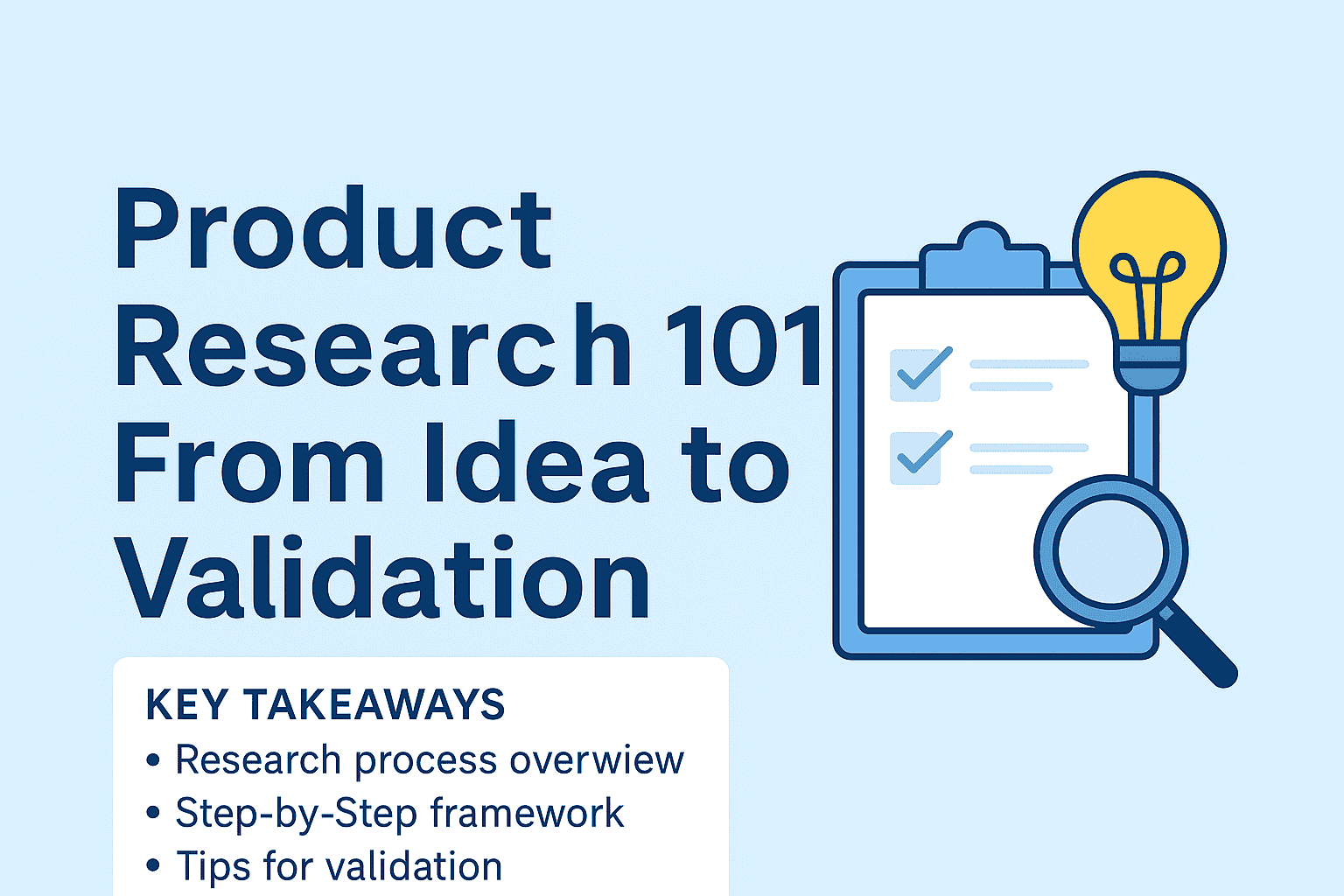
The ultimate guide to product research from idea to validation
This framework is the ultimate guide because it covers all angles—data, tools, and real-world testing. A Walmart Marketplace seller might use Walmart Connect Ads to test demand while monitoring competitors on Amazon. Both platforms give signals that lead to strong validation.
Product Research 101: idea testing and validation process
Testing is the final checkpoint before going all in. Let’s say a seller finds a trending gadget on Alibaba. Instead of buying 5,000 units, they test 100 units on Amazon and Walmart. Tools like Jungle Scout or DataSpark track performance. If sales hold, that idea is now validated and ready for scale.
From Idea Generation to Initial Validation
Every winning product on Amazon and Walmart starts with a simple idea. But ideas alone aren’t enough. Sellers need to test and validate them before ordering in bulk. This stage bridges creative brainstorming with hard data.
Table: From Idea to Validation
| Stage | Action | Tool / Source | Example |
|---|---|---|---|
| Idea Spark | Spot trends | TikTok, Instagram, Pinterest | Viral smoothie blenders |
| Early Research | Gauge demand | Amazon Keyword Tool, Walmart Trends | Rising searches for yoga mats |
| Pre-Validation | Run micro-tests | Facebook Ads, Google Ads | Test 50-unit batch |
Bullet Points: Why Idea Validation Matters
-
Stops sellers from betting on “gut feel” alone.
-
Helps confirm if Amazon FBA or Walmart Marketplace has real demand.
-
Saves money by testing before large Alibaba orders.
-
Builds confidence before scaling up inventory.
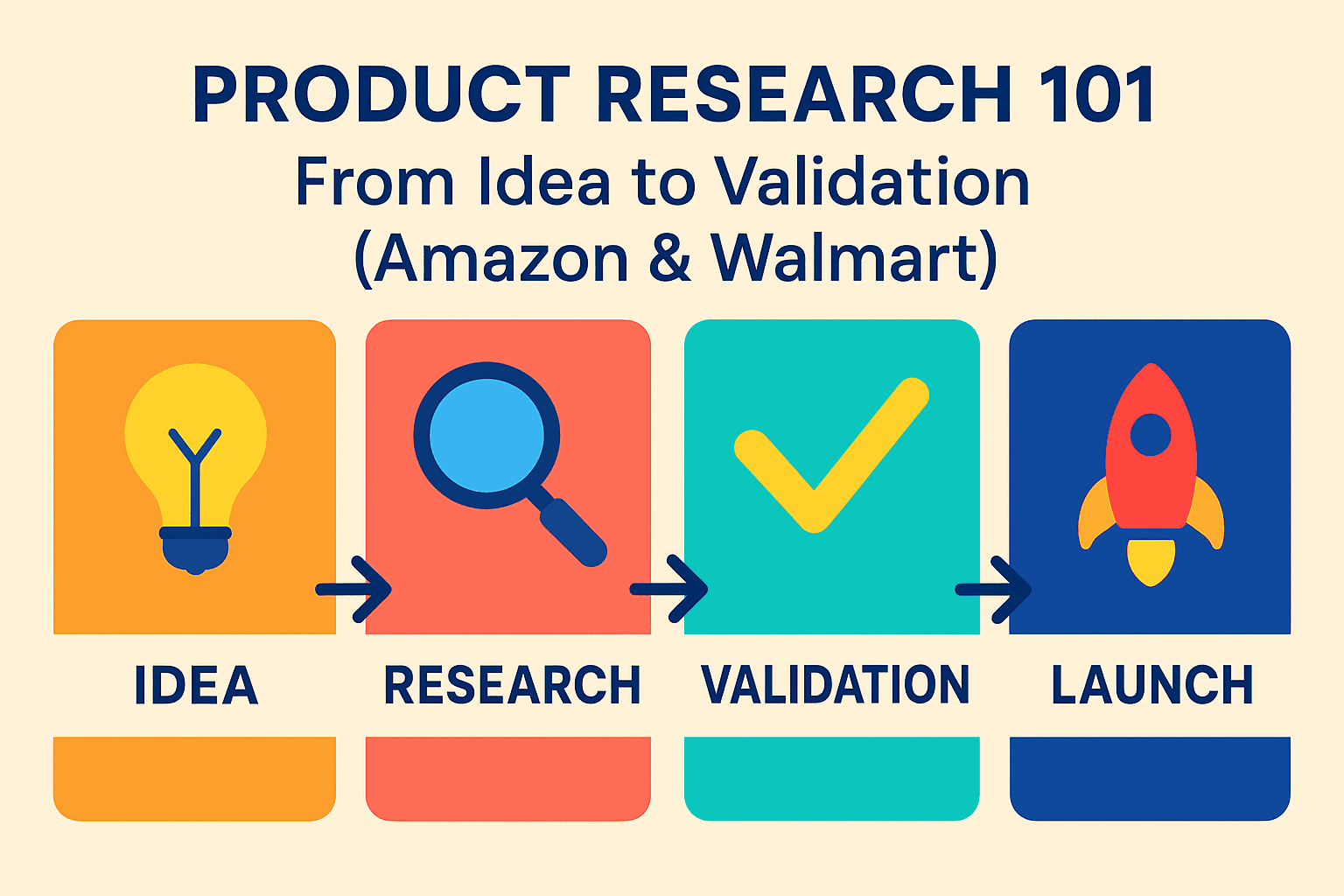
How to go from product idea to market validation
Start by spotting trends. Maybe you see a surge in Stanley Cups on TikTok or a fresh wave of eco-friendly cleaning tools on Amazon. From there, dig into data: check keyword searches, product rankings, and reviews. Once numbers look promising, run a small test batch on Amazon FBA or Walmart Marketplace to see if shoppers actually buy.
How to research product ideas before launch
Research means looking at both demand and competition. Tools like Helium 10, Keepa, and DataSpark show how many people are searching, what prices look like, and how often items sell. For example, if Amazon Best Sellers shows a steady trend in home fitness gear, and competition is thin, that idea could be worth testing.
Validating product ideas: Product Research 101
Validation is about proof. Sellers often order a small batch through Alibaba or a local supplier, then launch test listings on Amazon or Walmart. If ads convert and reviews roll in, validation is complete. This step weeds out products that look good on paper but flop in reality.
Amazon Product Research & Validation
Selling on Amazon is competitive, but the right research separates winners from flops. The goal is to move from a raw idea to proof of demand using tools, testing, and strategy.
Table: Amazon Product Research Workflow
| Step | Task | Tool / Source | Example |
|---|---|---|---|
| 1 | Spot ideas | Amazon Best Sellers, Google Trends | Wireless chargers |
| 2 | Check demand | Helium 10, Jungle Scout | High search volume keywords |
| 3 | Study competition | Keepa, review analysis | Top listings with weak images |
| 4 | Validate pricing | CamelCamelCamel, Keepa | Stable $19.99 price point |
| 5 | Test batch | 50–100 units via FBA | Eco-friendly tumblers |
Bullet Points: Why Amazon Validation Counts
-
Avoids sinking money into dead inventory.
-
Shows what actually works in Amazon FBA.
-
Builds a data-driven launch strategy.
-
Gives sellers confidence to scale.
Product Research 101 for Amazon sellers: from idea to validation
For Amazon sellers, product research means checking demand, competition, and profit margins. For instance, spotting reusable kitchen tools trending on Amazon Best Sellers, then testing a batch through Amazon FBA, ensures sellers don’t bet on hype alone.
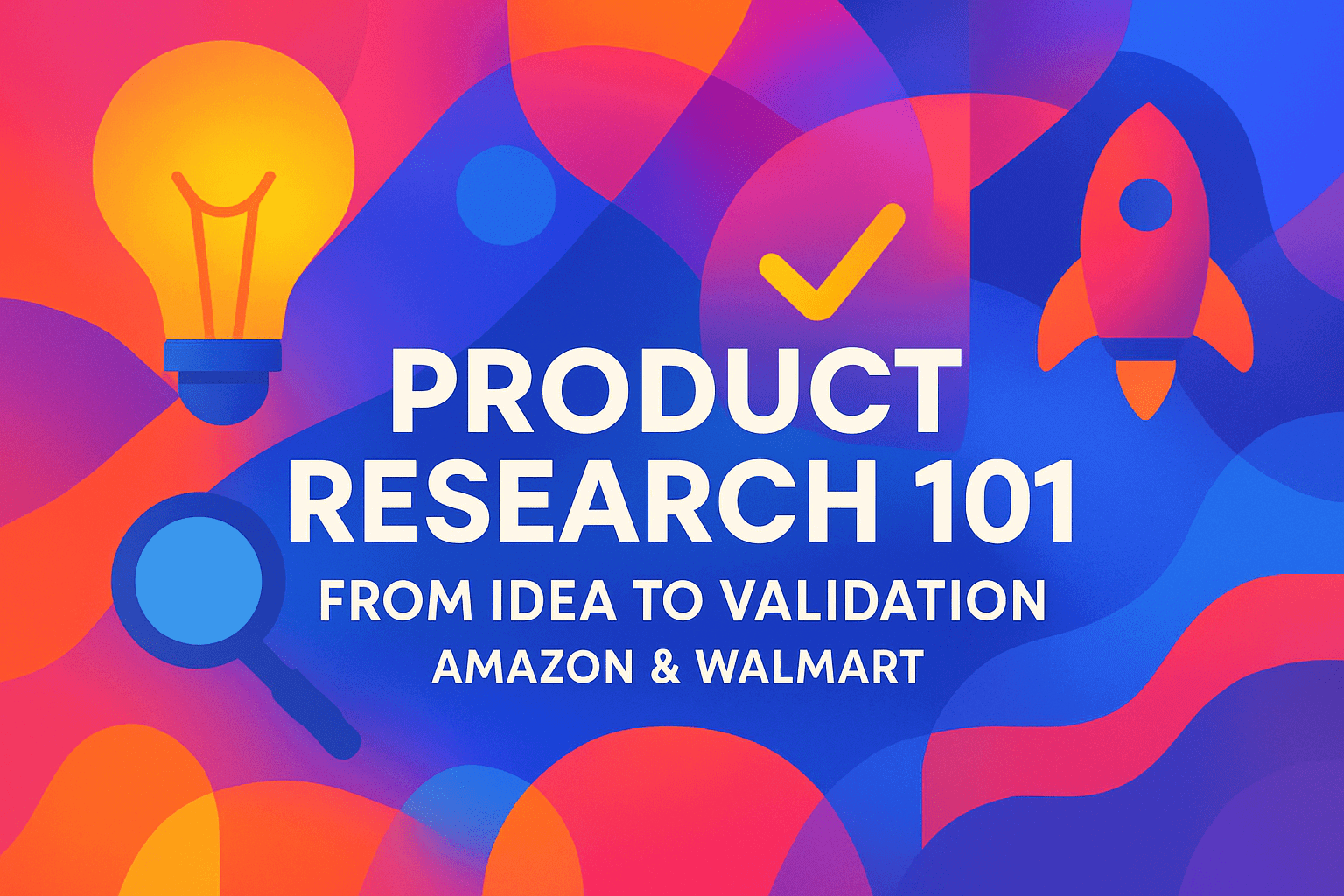
Amazon product research from idea to validation
Research starts with idea generation from platforms like TikTok or Pinterest, then filters down using Helium 10 or Jungle Scout. Validation comes when you run a test listing through Amazon FBA and track performance using Keepa charts.
Step-by-step Amazon product research and validation
The step-by-step system looks like this:
-
Brainstorm niches.
-
Check keyword demand.
-
Study competitors’ listings.
-
Validate pricing trends.
-
Test small-scale FBA batches.
This method keeps Amazon FBA sellers focused on numbers, not guesses.
Validating product ideas for Amazon FBA
Validation is about real sales data. A seller might test a 100-unit order from Alibaba, launch via Amazon FBA, and run sponsored ads. If conversion rates and reviews look solid, the idea is officially validated.
Amazon Marketplace Product Research 101
The Amazon Marketplace offers endless options, but not all are good picks. Research ensures sellers don’t compete in saturated niches like phone cases, where big brands dominate. Instead, they target gaps like ergonomic desk gear or sustainable storage solutions.
From idea to validation: Amazon product selection guide
A smart selection guide means checking margins, shipping costs, and demand. Tools like CamelCamelCamel and Keepa help monitor price history, while Helium 10 confirms keyword traffic. With this guide, sellers move from a cool idea to a proven product.
How to research and validate products on Amazon
It’s a mix of art and science. Sellers use data tools, supplier platforms like Alibaba, and trend sources like Reddit or Instagram. Validation happens when listings perform well under small ad spend, showing buyers are ready to pay.
Walmart Product Research & Validation
The Walmart Marketplace is growing fast, but fewer sellers means wide-open chances. The trick? Move from idea to validation with data-driven steps, just like on Amazon, but using Walmart-focused tools.
Table: Walmart Product Research Workflow
| Step | Task | Tool / Source | Example |
|---|---|---|---|
| 1 | Spot product ideas | Walmart Search Bar, Google Trends | Air fryers |
| 2 | Gauge demand | Walmart Trends, DataSpark | Surge in camping gear |
| 3 | Check competition | Review count & listing quality | Few reviews on niche items |
| 4 | Validate pricing | Track Walmart price ranges | Steady $29.99 |
| 5 | Test demand | Walmart Connect Ads, small-batch listing | Eco-friendly storage bins |
Bullet Points: Why Walmart Validation Counts
-
Walmart Marketplace has less competition than Amazon.
-
Helps sellers catch trends before they saturate.
-
Data prevents dead inventory on shelves.
-
Ads and small-batch runs prove demand fast.
Product Research 101 for Walmart Marketplace
For Walmart sellers, research starts with spotting what shoppers search for. Tools like Walmart Trends or DataSpark show what’s hot. For example, a spike in outdoor grills might signal a good product path.
From product idea to validation on Walmart
Ideas move to validation when tested on Walmart Marketplace. Sellers may launch a limited listing with ads through Walmart Connect. If it gets clicks, reviews, and steady sales, the idea is validated.
Walmart product research step-by-step guide
Here’s the breakdown:
-
Spot trends in Walmart search results.
-
Check demand via DataSpark.
-
Study reviews and competitor listings.
-
Confirm profit margins.
-
Test a batch of 50–100 units.
This simple guide helps new sellers start small and safe.
Validating product ideas for Walmart sellers
Validation often means running Walmart Connect Ads on a small scale. For instance, testing 100 units of pet accessories with ads can prove if buyers are serious. If ads convert, the product is ready for scale.
Walmart Marketplace product research 101
The Walmart Marketplace works best for products that aren’t flooded by big-box brands. Instead of diving into crowded niches like toys or electronics, sellers can thrive in home storage or kitchen gadgets, where gaps are bigger.
How to research and validate products on Walmart
Researching on Walmart Marketplace is about using DataSpark, keyword checks, and competitor analysis. Sellers watch pricing, demand, and review patterns. Validation comes when ads and test listings show steady sales.
From idea to validation: Walmart product sourcing
Once validated, sourcing comes next. Sellers often use Alibaba, but they can also partner with U.S. wholesalers. The key is to keep costs low while maintaining Walmart’s pricing standards. For example, sourcing eco-friendly bins from a U.S. supplier may cut shipping times, boosting sales.
Advanced Strategies & Insights
Once you’ve nailed the basics on Amazon and Walmart Marketplace, it’s time to level up. Advanced product research helps you avoid costly flops, spot untapped niches, and grow smarter.
Table: Advanced Product Research Tactics
| Strategy | Tool / Source | Example |
|---|---|---|
| Cross-Platform Validation | Amazon, Walmart, eBay | Check if eco-friendly bottles sell well everywhere |
| Trend Forecasting | Google Trends, Pinterest, TikTok | Early signals on fitness bands |
| Pricing Intelligence | Keepa, CamelCamelCamel | Detect hidden pricing gaps |
Bullet Points: Why Go Advanced
-
Avoids relying on one marketplace alone.
-
Helps you spot cross-platform trends early.
-
Reduces the chance of stocking a flop.
-
Let’s you scale with confidence across Amazon FBA and Walmart Marketplace.
Complete guide to validating product ideas in eCommerce
A complete validation process goes beyond one platform. For example, if a product does well on Amazon, cross-checking with Walmart Trends or eBay Sold Listings gives extra proof. Sellers use tools like Helium 10, DataSpark, and Google Trends together to paint the full picture.
Product research strategies: from idea to validation in online marketplaces
Smart strategies combine data and timing. A seller may see TikTok influencers hyping fitness bands, confirm demand on Amazon Best Sellers, then test on Walmart Marketplace. This multi-step flow ensures sellers ride trends at the right moment instead of too late.
Product Research 101: Avoid failure with idea validation
Failure often happens when sellers skip validation. Buying 2,000 units from Alibaba without testing is risky. Instead, advanced sellers run micro-batches on Amazon FBA or Walmart, track ad performance, and scale only when the proof is solid. This step saves thousands in wasted capital.
Conclusion
The journey from product idea to validation isn’t guesswork. It’s a repeatable system that works across Amazon FBA and Walmart Marketplace. Sellers who take the time to research, test, and validate cut down on risk while boosting their odds of success.
Table: Final Validation Checklist
| Step | Question | Tool / Action |
|---|---|---|
| Demand | Do shoppers want this? | Amazon Best Sellers, Walmart Trends |
| Competition | Can I stand out? | Review analysis, Helium 10, DataSpark |
| Pricing | Are margins healthy? | Keepa, CamelCamelCamel |
| Validation | Did my test sell? | Small-batch via FBA or Walmart listing |
Bullet Points: Closing Insights
-
Research before bulk-buying from Alibaba or local suppliers.
-
Use Helium 10, Jungle Scout, and DataSpark for reliable data.
-
Test micro-batches on Amazon FBA or Walmart Marketplace.
-
Double-check demand with tools like Google Trends and Pinterest.
-
Treat product research like insurance—it saves money and stress.
Call to Action
You now hold the Product Research 101: From Idea to Validation roadmap. The ball’s in your court.
-
Pick one idea this week.
-
Run it through tools like Helium 10 or DataSpark.
-
Order a small test batch via Alibaba.
-
Launch it on Amazon or Walmart Marketplace.
Don’t wait for the “perfect” product. The best sellers move fast, test small, and scale smart.
👉 Ready to take the leap? Start your first validation run today, and let your next idea be the one that wins big.